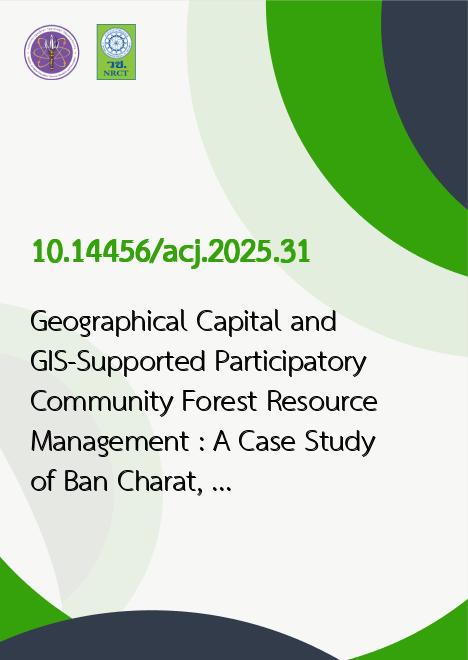
|
Geographical Capital and GIS-Supported Participatory Community Forest Resource Management : A Case Study of Ban Charat, Buachet District, Surin Province |
|---|---|
| รหัสดีโอไอ | |
| Creator | Wanomporn Pahanit |
| Title | Geographical Capital and GIS-Supported Participatory Community Forest Resource Management : A Case Study of Ban Charat, Buachet District, Surin Province |
| Contributor | Suphattra Wayalun |
| Publisher | The Office of Arts and Culture, Surindra Rajabhat University |
| Publication Year | 2568 |
| Journal Title | Arts and Culture Journal of the Lower Moon River |
| Journal Vol. | 14 |
| Journal No. | 2 |
| Page no. | 422-436 |
| Keyword | Geographical Capital, Geographic Information System, Resource Management, Participation, Community Forest |
| URL Website | https://so07.tci-thaijo.org/index.php/acj |
| Website title | วารสารศิลปะและวัฒนธรรมลุ่มแม่น้ำมูล |
| ISSN | ISSN 2822 - 0617 (Online);ISSN 2822 - 1141 (Print) |
| Abstract | This research aims to : 1) study the geographic cost conditions in the management of community forest resources; 2) examine public participation in the management of community forest resources; and 3) propose appropriate guidelines for the development and management of community forest resources. The case study focuses on the Ban Jaras School Community Forest, Jaras Sub-district, Buachet District, Surin Province. This study employed a mixed methods research approach using a Sequential Explanatory Design, in which quantitative data were collected first, followed by qualitative data to explain the results. Quantitative data were gathered using questionnaires from a sample of 229 participants, while qualitative data were obtained through in-depth interviews with 64 stakeholders, focus group discussions with 15 participants, field observations, and spatial data analysis using Geographic Information Systems (GIS). The findings revealed that the community forest area possesses high geographic cost characteristics, including an average slope of 15 - 25 degrees, an average distance of 2.3 kilometers from the community, accessibility difficulties during the rainy season (average score 2.1), and risks from natural hazards. These factors directly affect the efficiency of resource management in the area. Nevertheless, the community has adapted and managed these limitations effectively through participatory processes (average satisfaction score 4.55), such as the establishment of conservation groups, utilization of schools as learning centers, creation of firebreaks, construction of check dams, and cultural activities such as forest ordination ceremonies. According to the community’s satisfaction survey regarding geographic costs in community forest resource management, the respondents' opinions ranged from high (average score 4.30) to the highest (average score 4.77) concerning geographic cost conditions, public participation, and management approaches. Notably, strong participation in community activities and support for conservation initiatives reflect acceptance and satisfaction with the current management models. The study recommends promoting the use of geographic information systems alongside local wisdom, encouraging participation from all sectors, and establishing collaborative networks between communities and government agencies to enhance the sustainable management of community forest resources in the long term. |